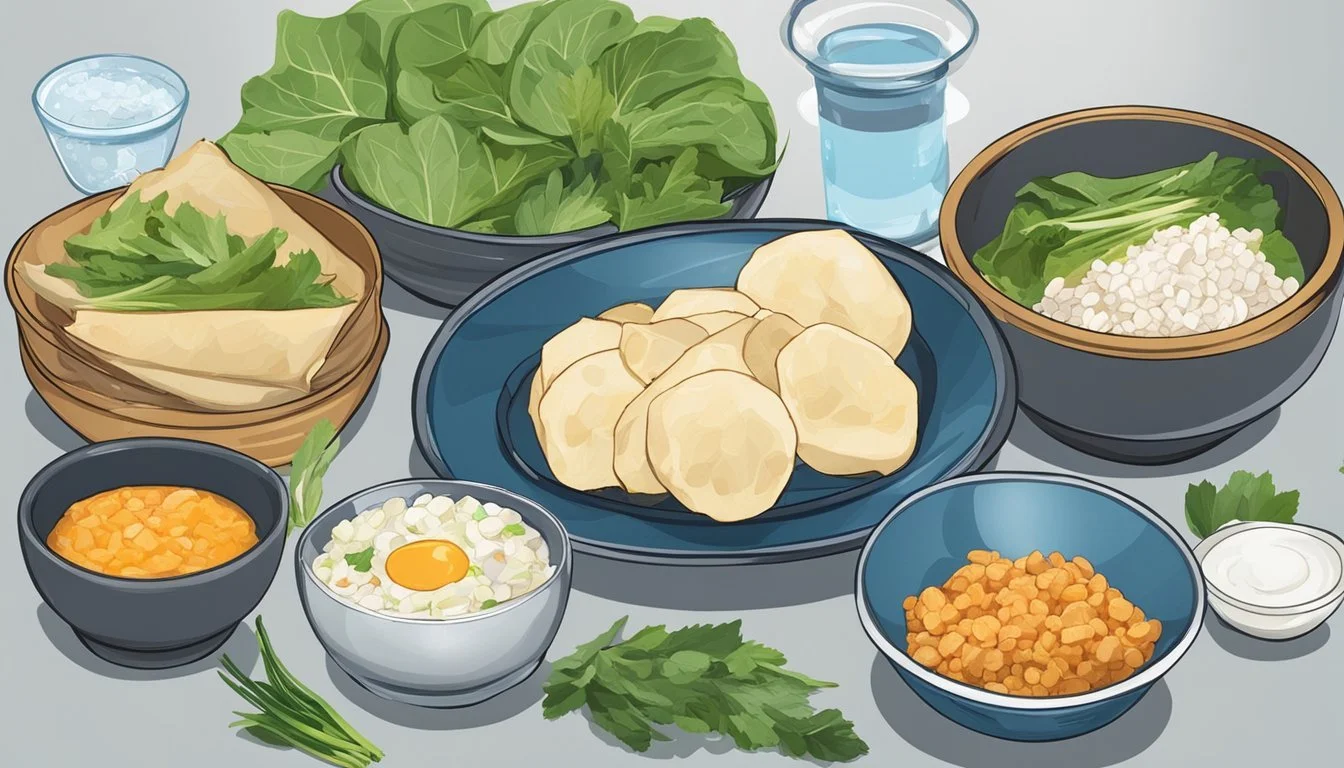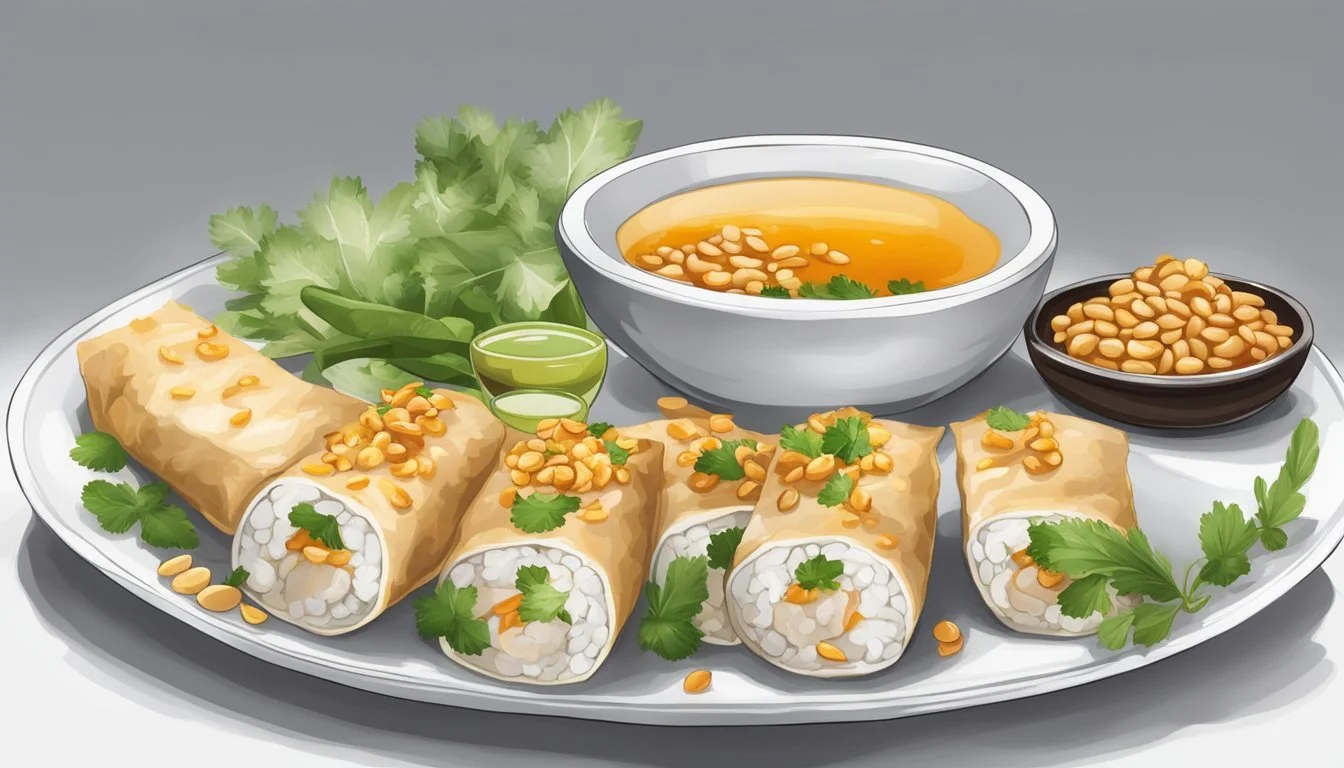Best Way to Reheat Goi Cuon
Tips for Freshness and Crunch Retention
Goi Cuon, known commonly as Vietnamese fresh spring rolls, occupy a beloved spot in Vietnamese cuisine as a classic appetizer. Unlike fried spring rolls, Goi Cuon consists of a delicate rice paper wrapper encasing a harmonious blend of fresh herbs, pork, shrimp, and vermicelli noodles. Often referred to as salad rolls or summer rolls, they are typically served fresh to preserve the texture and flavors that define their refreshing quality.
However, when faced with the need to reheat these rolls, preserving their distinctive crispness and freshness becomes a culinary challenge. The nature of Goi Cuon, with its combination of both moist and dry ingredients, demands a reheating method that maintains the integrity of the rice paper while revitalizing the core ingredients to evoke the sensation of a just-made roll.
Navigating this process requires a balance between gentle heat and the correct environment, to ensure the rolls regain the ideal temperature without becoming overly soggy or losing their structural integrity. Whether Goi Cuon has been stored in the refrigerator or left at room temperature for a short period, employing the right reheating technique is crucial for reviving these Vietnamese delights without compromising their original texture and taste.
Ingredients Overview
Goi Cuon, a Vietnamese delicacy known for its fresh and vibrant ingredients, comes together to create rolls that are both healthy and flavorful. Understanding the ingredients is crucial for ensuring that the Goi Cuon retains its freshness and crunchiness when reheated.
Proteins in Goi Cuon
Proteins play a significant role in Goi Cuon, offering a rich and savory flavor. Common proteins include:
Shrimp: Often poached until pink and curled.
Pork: Options like pork loin or pork belly are boiled until fully cooked.
Tofu: A plant-based alternative that is typically fried or baked.
Herbs and Vegetables
The freshness of Goi Cuon comes from an abundance of herbs and vegetables. These may consist of:
Lettuce, Mint, Basil: Provide crisp textures and fresh flavors.
Carrot, Cucumber: Often julienned, adding a sweet and crunchy component.
Bean Sprouts, Cilantro, Chives: Enhance the rolls with their unique tastes and textures.
Vietnamese Herbs: Such as perilla or garlic chive, add depth to the flavor profile.
Wrappers and Fillings
The encasement and carbohydrate elements of Goi Cuon include:
Rice Paper (made with rice flour and tapioca starch): Serves as a translucent wrapper that's pliable when moistened.
Vermicelli Noodles (rice vermicelli or bun): These soft, white noodles are boiled and then cooled.
Dipping Sauces and Seasonings
No Goi Cuon is complete without its signature dipping sauces, which add a burst of flavor:
Peanut Sauce: Combines hoisin sauce, peanut butter, sugar, and water for a sweet and savory taste.
Nuoc Cham: A traditional Vietnamese dipping sauce made with garlic, sugar, lime juice, fish sauce, and water.
Hoisin Sauce: Can be used on its own or mixed with ingredients like garlic and peanut butter to create a more complex sauce.
Preparing Goi Cuon
Perfect Goi Cuon, also known as Vietnamese fresh spring rolls or nem cuốn, begin with the selection of high-quality, fresh ingredients, and attention to detail during assembly. Mastery of the rolling technique is essential to ensure a tight, evenly wrapped roll that maintains the integrity of the textures and flavors.
Selecting Fresh Ingredients
The foundation of authentic Vietnamese fresh spring rolls is predicated on the use of fresh, high-quality ingredients. They should prioritize:
Proteins: Typically, cooked shrimp and pork belly, sliced into thin pieces.
Herbs & Vegetables: Fresh lettuce, mint, cilantro, and thin rice vermicelli noodles.
Wrappers: Rice paper that becomes pliable when dampened.
Ingredient Quality Indicator Shrimp Bright color, firm texture, no odor Pork Belly Fresh, pale pink color Herbs & Lettuce Vibrant color, crisp leaves Rice Vermicelli Dry and brittle before cooking Rice Paper Intact, no tears or significant drying
Assembly Instructions
To assemble Goi Cuon, one should follow specific step-by-step instructions that ensure each roll is well-constructed:
Prepare Station: Lay out the ingredients for easy accessibility.
Hydrate Rice Paper: Dip rice paper into warm water until just pliable and lay flat on a clean surface.
Layer Ingredients: Place a small amount of lettuce, herbs, vermicelli noodles, pork, and shrimp onto the rice paper.
Creating the Perfect Roll
The rolling technique is crucial in creating a Goi Cuon that is tight yet not overstuffed, capturing the essence of the dish:
Begin the roll by folding the bottom half of the rice paper over the filling.
Fold in the sides to encase the fillings.
Continue rolling firmly but gently to avoid tearing the rice paper.
The final product should be a tight, translucent roll that allows the colors of the ingredients to show through.
In summary, focus on the quality of ingredients and meticulous assembly ensures Vietnamese fresh spring rolls that are authentic and enjoyable to eat.
Reheating Techniques
In reheating goi cuon (Vietnamese spring rolls), the primary goal is to preserve their freshness and texture. It's crucial to adopt methods that maintain the crunch of the vegetables while warming the rolls gently.
Maintaining Freshness and Crunch
To keep goi cuon fresh and crunchy, one should never use the microwave since it can make the rice paper wrapper tough and chewy. Instead, focus on methods that reheat gently, such as using a skillet or air fryer. Wrapping them individually with a damp paper towel can help to retain moisture and texture before applying heat.
Skillet Method
Reheating goi cuon in a skillet over low heat ensures they warm without losing their crunch. Gently warm each side for 1-2 minutes, taking care not to dry out the rice paper wrapper. The skillet should be non-stick, ensuring minimal oil is required, hence preserving the roll's freshness.
Using an Air Fryer
An air fryer is a good alternative for reheating goi cuon. Preheat the air fryer to around 300°F (150°C). Place the rolls in the air fryer basket, ensuring they are not touching, and heat briefly, for about 3-4 minutes. The circulating air helps to maintain the rolls' freshness and avoid sogginess. Covering them with a lightly dampened paper towel in the basket can additionally protect their texture.
Serving and Presentation
When serving Goi Cuon, often known as Vietnamese fresh spring rolls, the freshness and visual appeal are paramount. They should be presented in a way that entices the eater visually, then satisfies their palate.
Plating Goi Cuon
To retain the rolls' vibrant look and freshness, place them on a leafy green bed, such as lettuce, which adds to the presentation while keeping the rolls from sticking to the plate. Cut the rolls in half diagonally to expose the colorful filling, offering guests a peek at the shrimp, vermicelli, and herbs inside. Arrange them neatly with the cut side up, allowing the ingredients to be the focus of the dish.
Pairing with Dipping Sauces
Dipping sauces are indispensable to the Goi Cuon experience. Offer each diner a small bowl for sauce, which can be peanut sauce or hoisin-based. Another authentic Vietnamese choice is nuoc cham, a mixture of fish sauce, water, sugar, lime, and chili. Present these sauces in separate bowls, ensuring they are thick enough to cling to the rolls without being overly dense.
Accompaniments and Side Dishes
Goi Cuon is often enjoyed as an appetizer or a light meal on its own. However, it pairs wonderfully with other Vietnamese dishes for a more complete dining experience. A bowl of pho with its hearty broth or a banh mi sandwich can complement the freshness of the rolls. Variations may include additional salads or summer rolls, ensuring a rich, textured meal where the Goi Cuon still shines as the star.
Cultural Significance
Gỏi cuốn plays a significant role in Vietnamese culture, often reflecting the country's tradition and global culinary influence.
Goi Cuon in Vietnamese Tradition
Vietnamese cuisine stands out for its balance of fresh ingredients, and gỏi cuốn, also known as Vietnamese fresh spring rolls, is a prime example of this tradition. Originating in Vietnam, these rolls are a staple in both street food culture and home cooking. They are traditionally served in Saigon (now Ho Chi Minh City) and Hanoi, encapsulating flavors that span across the nation. Unlike the fried spring rolls, gỏi cuốn is wrapped in rice paper and contains a combination of greens, meats like pork or shrimp, and sometimes rice vermicelli. This dish is often enjoyed during Vietnamese festivities and family gatherings.
Popularity Beyond Vietnam
The international popularity of gỏi cuốn has surged with the rise of social media platforms like Instagram, Facebook, Pinterest, and YouTube, where the aesthetic appeal of the vibrant, translucent rolls garners significant attention. This has led to gỏi cuốn being widely recognized as a healthy and flavorful option, often featured in Vietnamese restaurants worldwide. Its appeal goes beyond borders, with many culinary enthusiasts trying to recreate the dish, which has been influenced by the Vietnamese diaspora and the global curiosity for authentic Vietnamese flavors.
Variations and Dietary Preferences
Goi Cuon, a versatile Vietnamese dish, adapts to an array of dietary preferences, ranging from authentic cultural renditions to innovative modern interpretations that accommodate various dietary restrictions.
Traditional vs. Modern Twists
Traditional Goi Cuon: These rolls are typically filled with cooked pork, shrimp, vermicelli noodles, lettuce, and a variety of herbs wrapped in rice paper. Authentic Vietnamese Goi Cuon emphasizes a harmony between fresh ingredients and savory flavors.
Modern Interpretations: Chefs are introducing modern twists to Goi Cuon by incorporating unique proteins such as grilled chicken, beef, or tofu. Others experiment with different herb combinations or add ingredients like mango for a sweet note.
Vegetarian and Vegan Options
Vegetarian Variations: A vegetarian dish can include tofu as a protein substitute, with an abundance of fresh veggies and herbs. These ingredients retain the freshness and crunch Goi Cuon is known for.
Vegan Choices: For a vegan version, it's essential to select fillings and sauces free of animal products. The traditional fish sauce can be swapped out with a soy-based sauce, while fillings veer towards plant-based ingredients like avocado and bell peppers.
Frequently Asked Questions (FAQs)
In this section, readers will find expert advice on how to store leftover Gỏi Cuốn and address issues related to reheating and maintaining their freshness.
Storage and Leftovers
Properly storing Gỏi Cuốn ensures their freshness and quality. Leftovers should be kept in an airtight container and refrigerated within two hours of serving. For the best quality, they should be consumed within the next 24 hours as they contain perishable items like pork and shrimp. To help maintain their moisture, one may cover them with a damp paper towel before sealing the container.
Dealing with Common Issues
When reheating Gỏi Cuốn, one might encounter sogginess or loss of texture. To reheat, a toaster oven is recommended:
Preheat to 250-350⁰F.
Place spring rolls on a tray.
Bake for 3-6 minutes on each side.
If needed, continue heating for an additional minute on each side. However, this method works best for fried spring rolls. Fresh Gỏi Cuốn may not reheat well due to their delicate ingredients and rice paper wrapper. If freshness is compromised, it is recommended to enjoy them cold or at room temperature to maintain their original texture.







